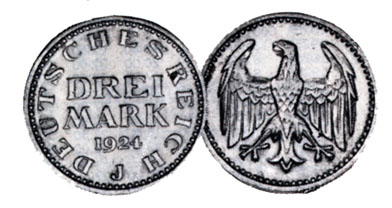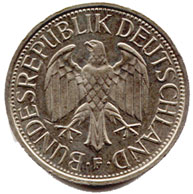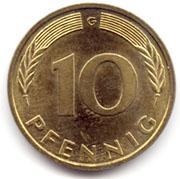
Letters Indicate German Mints

There are five different mints in German Federal Republic, probably world record at present. The respective mints are easily to be distinguished in watching the little letter indicated. You may find the letters A, D, G, F and J standing for the government mints in Berlin, Munich, Stuttgart, Karlsruhe and Hamburg.
Why have these letters been given to those mints? In 1750 Friedrich the Great of Prussia ordered, that the mint of his capital Berlin should use the letter A in future. Berlin mint continued to use this letter to date.

The three Prussian mints which were in use in the year of German unification (1871) continued issuing coins with their old marks. They were A-Berlin, B-Hannover (until 1878) and C-Frankfurt (until 1879).
The Prussian system was taken over by the other German states which –together with the kingdom of Prussia (founded 1701)- formed the German Empire after the French Empire of Napoleon III had lost the war of 1870/71. The individual German states lost their independence but they continued existing.
There was fixed a certain order of precedence according to which these countries were listed. This order was formed in accordance with the rank of the monarch and, if the monarchs had the same rank (king, duke...) according to the date the country started being a kingdom, grand duchy, duchy...
The second rank after Prussia was occupied by the kingdom of Bavaria.
As the first three letters of the alphabet had been reserved for Prussian mints, Munich, the capital of Bavaria, had to be satisfied with the letter of D (which is the mark of the Munich mint to date).
Shortly after Bavaria, Saxonia had become a kingdom in the first years of the 19th century, too, and so the Saxon mint in Dresden (later Muldenhütten near Dresden) got the Letter E (until 1953). The kingdom of Württemberg, the grand duchy of Baden and the grand duchy of Hessen were the mint-issuing German states placed next. The letters of Stuttgart (F), as the capital of Württemberg and Karlsruhe (G), the former residence and capital of Baden, are still in use today as both mints continue minting to date in Germany. The capital of Hesse (Darmstadt) was a mint until 1882 when the coin production came to an end. According to the order or precedence, the letter attributed to Darmstadt mint was H.

The confederate states forming the German Empire from 1871 to 1918 generally were monarchies. Otherwise there existed three republics (the towns: Hamburg, Bremen and Lübeck) and one of them, Hamburg, had a mint of its own. According to the official order of precedence, coins being minted in Hamburg had to show the letter J (it should be an I but for optical reasons it was decided to use J). As Hamburg continues minting to date, this letter will be recognized on a certain percentage of German coins to be issued annually.
After Austria had become part of Germany in 1938, the former Austrian mint of Wien (Vienna) continued minting (now instead of Austrian, German coins) and the coins of 1938-1944 can be distinguished by their mintmark. As the letter B was vacant since 1878 when Hannover finished minting, this letter was given to Vienna in 1938. Many collectors of Austrian coins collect "B-coins" of Germany from 1938-44 in addition to their Austrian coins.
In 1945 the allies decided to separate Austria from Germany again.
Reinhold Jordan